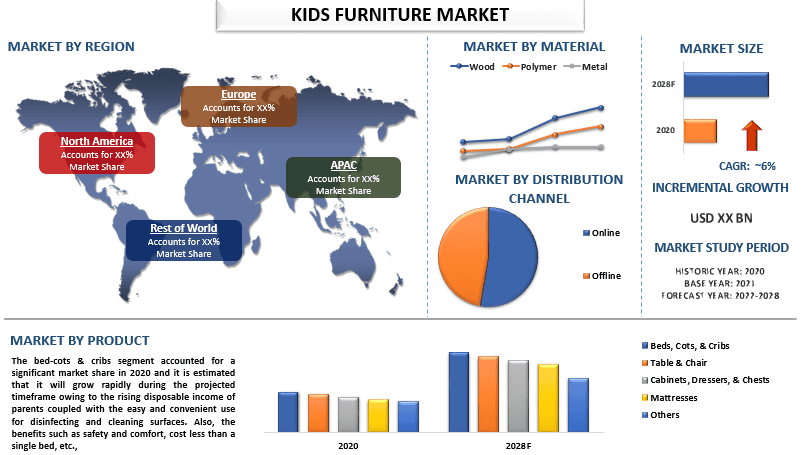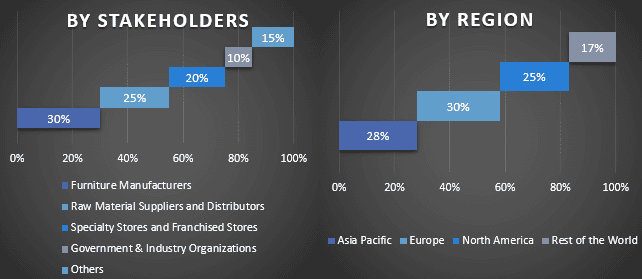- Home
- About Us
- Industry
- Services
- Reading
- Contact Us
Kids Furniture Market: Current Analysis and Forecast (2022-2028)
Emphasis on Product (Beds-Cots, & Cribs, Table & Chair, Cabinets, Dressers, & Chests, Mattresses, Others); Material (Wood, Polymer, Metal); End-User (Residential, Commercial); Distribution Channel (Online, Offline); and Region/Country

The global kids furniture market is expected to grow at a significant rate of around 6% during the forecast period 2022-2028. Emerging disposable income owing to the rising number of working parents coupled with the rapidly growing percentage of children in the countries such as the United States and Canada are contributing to the growing demand for kids’ furniture. Also, promulgating nuclear families in the counties is also acting as a growth catalyst to the industry.
Moreover, a surging investment in the kids room interior is contributing to the market growth. As per UNICEF, there are 1.3 billion adolescents in the world today, more than ever before, making up 16 percent of the world’s population. Consumers with a high level of affordability spend wisely in order to increase their standard of living, resulting in the purchase of efficient and versatile consumer goods. Also, surging preference for efficient and dedicated, themed spaces for kids in the form of nursery, play, and study rooms are contributing to the market growth. Housing contractors are adopting new strategies for developing end-to-end home infrastructures. As per a study in Europe, parents spend more than £5,300 decorating their child’s nursery and bedrooms – before they turn 10. Also, Parents will splash out a further £4,500 redecorating their children’s rooms at least once every two years – parting with £900 each time – before their 10th birthday.
Cello Group, Cosmoplast Industrial Company LLC, Herman Miller, Inter Ikea Systems B.V., Keter Group, Nilkamal Limited, Pil Italica Lifestyle Limited, Sauder Woodworking Company, Sleep Number Corporation, Tramontina, etc., are some of the key players in the market. Several M&As along with partnerships have been undertaken by these players to facilitate customers with hi-tech and innovative products/technologies.
Insights Presented in the Report
“Amongst product, beds- cots & cribs category to witness higher CAGR during the forecast period”
Based on product, the market is segmented into beds- cots & cribs, table & chairs, cabinets, dressers, & chests, mattresses, and others. The beds-cots & cribs segment grabbed the major market share in 2020 and dominated the market. The convenience and ease of use are some of the prominent factors. Also, factors such as the availability of tech-advanced beds and cribs, affordable prices, etc., are contributing to the growth of this segment.
“Amongst material, the wood segment to hold a significant share in the market in 2020”
On the basis of material, the market is categorized into wood, polymer, and metals. Among these, the wood segment grabbed the major market share and dominated the market in 2020. Wood is highly preferred for furniture by consumers due to its various advantages. Wood is much stronger in load bearing for both chairs and tables, owing to which wood can support a heavier load without breaking down.
“Amongst end-user, the residential segment to hold a significant share in the market in 2020”
Based on the end-user, the market is fragmented into residential and commercial. The residential segment grabbed the major market share and dominated the market in 2020. The COVID-19 pandemic positively impacted the growth of this particular segment as Schools remained closed and classes were conducted online, it was important to set up a comfortable classroom for the child at home to facilitate learning.
“North America to hold a significant share in the market”
North America region grabbed the major market share and dominated the market in 2020. The surging working population in the countries such as the United States and Canada is a key contributing factor to the demand for kids’ furniture in daycare. According to the U.S. Census Bureau, the youngest millennials reached their adulthood in 2020 and accounted for 28% of the U.S. population; they also accounted for 50% of the working population. However, APAC is anticipated to grow at a substantial CAGR during the forecast period. This is mainly due to the rising working population, emerging nuclear families, etc., As per United Nations, Department of Economic and Social Affairs, around 41.5% of families in India are nuclear families.
Reasons to buy this report:
- The study includes market sizing and forecasting analysis validated by authenticated key industry experts.
- The report presents a quick review of overall industry performance at one glance.
- The report covers an in-depth analysis of prominent industry peers with a primary focus on key business financials, product portfolio, expansion strategies, and recent developments.
- Detailed examination of drivers, restraints, key trends, and opportunities prevailing in the industry.
- The study comprehensively covers the market across different segments.
- Deep dive regional level analysis of the industry.
Customization Options:
The global Kids Furniture market can further be customized as per the requirement or any other market segment. Besides this, UMI understands that you may have your own business needs, hence feel free to connect with us to get a report that completely suits your requirements.
Table of Content
Research Methodology for the Kids Furniture Market Analysis (2022-2028)
Analyzing the historical market, estimating the current market, and forecasting the future market of the global kids furniture market were the three major steps undertaken to create and analyze the adoption of kids furniture in major regions globally. Exhaustive secondary research was conducted to collect the historical market numbers and estimate the current market size. Secondly, to validate these insights, numerous findings and assumptions were taken into consideration. Moreover, exhaustive primary interviews were also conducted, with industry experts across the value chain of the global Kids Furniture market. Post assumption and validation of market numbers through primary interviews, we employed a top-down/bottom-up approach to forecasting the complete market size. Thereafter, market breakdown and data triangulation methods were adopted to estimate and analyze the market size of segments and sub-segments of the industry pertains to. Detailed methodology is explained below:
Analysis of Historical Market Size
Step 1: In-Depth Study of Secondary Sources:
Detail secondary study was conducted to obtain the historical market size of the kids furniture market through company internal sources such as annual reports & financial statements, performance presentations, press releases, etc., and external sources including journals, news & articles, government publications, competitor publications, sector reports, third-party database, and other credible publications.
Step 2: Market Segmentation:
After obtaining the historical market size of the kids furniture market, we conducted a detailed secondary analysis to gather historical market insights and share for different segments & sub-segments for major regions. Major segments are included in the report as product, material, end-user, and distribution channel. Further country-level analyses were conducted to evaluate the overall adoption of testing models in that region.
Step 3: Factor Analysis:
After acquiring the historical market size of different segments and sub-segments, we conducted a detailed factor analysis to estimate the current market size of the kids furniture market. Further, we conducted factor analysis using dependent and independent variables such as surging disposable income, and the rising number of nuclear families, A thorough analysis was conducted for demand and supply-side scenarios considering top partnerships, mergers and acquisitions, business expansion, and product launches in the kids furniture market sector across the globe.
Current Market Size Estimate & Forecast
Current Market Sizing: Based on actionable insights from the above 3 steps, we arrived at the current market size, key players in the global kids furniture market, and market shares of the segments. All the required percentage shares split, and market breakdowns were determined using the above-mentioned secondary approach and were verified through primary interviews.
Estimation & Forecasting: For market estimation and forecast, weights were assigned to different factors including drivers & trends, restraints, and opportunities available for the stakeholders. After analyzing these factors, relevant forecasting techniques i.e., the top-down/bottom-up approach were applied to arrive at the market forecast for 2028 for different segments and sub-segments across the major markets globally. The research methodology adopted to estimate the market size encompasses:
- The industry’s market size, in terms of revenue (USD) and the adoption rate of the kids furniture market across the major markets domestically
- All percentage shares, splits, and breakdowns of market segments and sub-segments
- Key players in the global kids furniture market in terms of products offered. Also, the growth strategies adopted by these players to compete in the fast-growing market
Market Size and Share Validation
Primary Research: In-depth interviews were conducted with the Key Opinion Leaders (KOLs) including Top Level Executives (CXO/VPs, Sales Head, Marketing Head, Operational Head, Regional Head, Country Head, etc.) across major regions. Primary research findings were then summarized, and statistical analysis was performed to prove the stated hypothesis. Inputs from primary research were consolidated with secondary findings, hence turning information into actionable insights.
Split of Primary Participants in Different Regions

Market Engineering
The data triangulation technique was employed to complete the overall market estimation and to arrive at precise statistical numbers for each segment and sub-segment of the global kids furniture market. Data was split into several segments & sub-segments post studying various parameters and trends in the areas of product, material, end-user, and distribution channel in the global kids furniture market.
The main objective of the global kids furniture market Study
The current & future market trends of the global kids furniture market were pinpointed in the study. Investors can gain strategic insights to base their discretion for investments on the qualitative and quantitative analysis performed in the study. Current and future market trends determined the overall attractiveness of the market at a regional level, providing a platform for the industrial participant to exploit the untapped market to benefit from a first-mover advantage. Other quantitative goals of the studies include:
- Analyze the current and forecast market size of the kids furniture market in terms of value (USD). Also, analyze the current and forecast market size of different segments and sub-segments
- Segments in the study include areas of product, material, end-user, and distribution channel.
- Define and analysis of the regulatory framework for the kids furniture
- Analyze the value chain involved with the presence of various intermediaries, along with analyzing customer and competitor behaviors of the industry.
- Analyze the current and forecast market size of the kids furniture market for the major region.
- Major countries of regions studied in the report include Asia Pacific, Europe, North America, and the Rest of the World.
- Company profiles of the Kids Furniture market and the growth strategies adopted by the market players to sustain in the fast-growing market
- Deep dive regional level analysis of the industry
Related Reports
Customers who bought this item also bought










